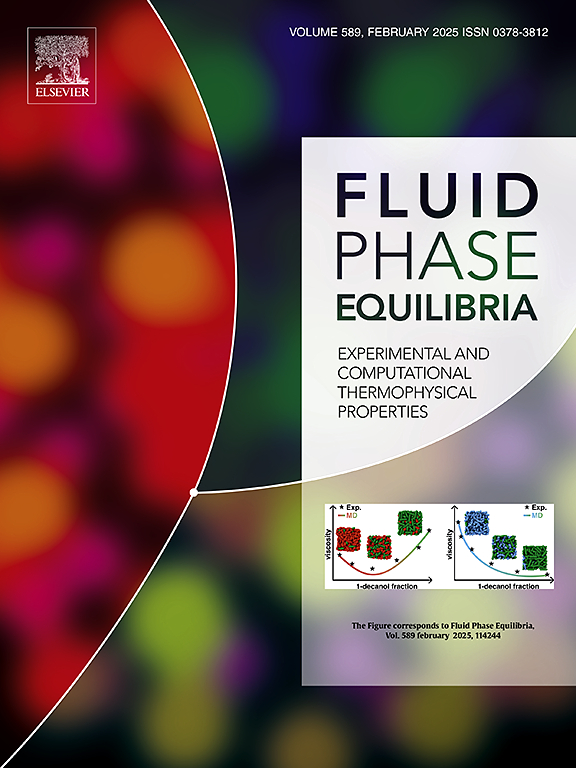Modeling CO₂ solubility in deep eutectic solvents using the saft-vr mie and pc-saft equations of state
IF 2.7
3区 工程技术
Q3 CHEMISTRY, PHYSICAL
引用次数: 0
Abstract
This study presents the first comparison of SAFT-VR Mie and PC-SAFT in modeling CO₂ solubility in Deep Eutectic Solvents (DESs). Experimental density data was used to adjust pure-component parameters (m, σ, and ε) for DESs in the SAFT models, whereas the unlike-segment interaction energy between CO₂ and the DES was either calculated with combining rules or optimized to reproduce experimental solubility data. A simplified Hudson-McCoubrey combining rule (ionization potentials assumed equal), applied for the first time to CO₂–DES systems, was compared with the conventional Lorentz-Berthelot rule. Four hydrophilic and six hydrophobic DESs were modeled as pseudo-pure components, either as non-associating or associating species, following 2B or 4C association schemes in both equations of state. It was found that the Lorentz-Berthelot rule is unsuitable for CO₂–DES phase equilibrium modeling, particularly for hydrophobic DESs, while the Hudson-McCoubrey rule provided excellent agreement with experimental data for both SAFT-VR Mie and PC-SAFT, performing comparably to models with unlike-segment interaction energy obtained empirically. The 2B and 4C association schemes produced accurate solubility predictions and demonstrated slightly superior performance compared to the inert approach, particularly in the case of hydrophobic DESs. Additionally, CO₂ was modeled as either a neutral component or with 2B cross-association with DES, showing no significant difference in results. Finally, Helmholtz energy contributions to the residual pressure of pure hydrophobic DESs were analyzed, revealing that while association effects were minor, they positively influenced CO₂ solubility predictions.
用saft-vr - mie和pc-saft状态方程模拟co2在深共晶溶剂中的溶解度
这项研究首次比较了SAFT-VR Mie和PC-SAFT在模拟CO₂在深共晶溶剂(DESs)中的溶解度。实验密度数据用于调整SAFT模型中DES的纯组分参数(m、σ和ε),而CO₂与DES之间的非同段相互作用能则采用组合规则计算或优化以再现实验溶解度数据。首次将简化的Hudson-McCoubrey组合规则(假设电离势相等)应用于CO₂-DES体系,并与传统的Lorentz-Berthelot规则进行了比较。四种亲水性和六种疏水性DESs被建模为伪纯组分,要么是非缔合的,要么是缔合的,在两个状态方程中遵循2B或4C缔合方案。结果表明,Lorentz-Berthelot规则不适用于CO₂-DES相平衡模型,尤其是疏水des相平衡模型,而Hudson-McCoubrey规则与SAFT-VR Mie和PC-SAFT的实验数据非常吻合,与经验获得的非段相互作用能模型相当。与惰性方法相比,2B和4C结合方案产生了准确的溶解度预测,并显示出略优于惰性方法的性能,特别是在疏水DESs的情况下。此外,CO₂被建模为中性成分或与DES具有2B交叉关联,结果没有显着差异。最后,我们分析了亥姆霍兹能对纯疏水DESs残余压力的贡献,发现虽然关联效应很小,但它们对CO 2溶解度的预测有积极影响。
本文章由计算机程序翻译,如有差异,请以英文原文为准。
求助全文
约1分钟内获得全文
求助全文
来源期刊

Fluid Phase Equilibria
工程技术-工程:化工
CiteScore
5.30
自引率
15.40%
发文量
223
审稿时长
53 days
期刊介绍:
Fluid Phase Equilibria publishes high-quality papers dealing with experimental, theoretical, and applied research related to equilibrium and transport properties of fluids, solids, and interfaces. Subjects of interest include physical/phase and chemical equilibria; equilibrium and nonequilibrium thermophysical properties; fundamental thermodynamic relations; and stability. The systems central to the journal include pure substances and mixtures of organic and inorganic materials, including polymers, biochemicals, and surfactants with sufficient characterization of composition and purity for the results to be reproduced. Alloys are of interest only when thermodynamic studies are included, purely material studies will not be considered. In all cases, authors are expected to provide physical or chemical interpretations of the results.
Experimental research can include measurements under all conditions of temperature, pressure, and composition, including critical and supercritical. Measurements are to be associated with systems and conditions of fundamental or applied interest, and may not be only a collection of routine data, such as physical property or solubility measurements at limited pressures and temperatures close to ambient, or surfactant studies focussed strictly on micellisation or micelle structure. Papers reporting common data must be accompanied by new physical insights and/or contemporary or new theory or techniques.
 求助内容:
求助内容: 应助结果提醒方式:
应助结果提醒方式:


